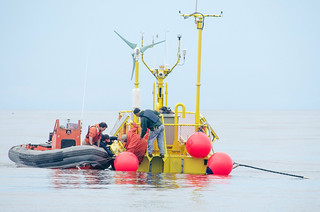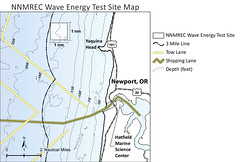 One of the first public wave energy testing systems in the United States began operation this week off the Oregon coast near Newport, and will allow private industry or academic researchers to test new technology that may help advance this promising form of sustainable energy.
One of the first public wave energy testing systems in the United States began operation this week off the Oregon coast near Newport, and will allow private industry or academic researchers to test new technology that may help advance this promising form of sustainable energy.
Ocean Sentinel is a $1.5 million device developed by the Northwest National Marine Renewable Energy Center, or NNMREC, at Oregon State University. The device was towed to the Center’s designated testing site 2 miles offshore from Yaquina Head on Sunday by OSU’s R/V Pacific Storm, and attached to a battery of mooring anchors that will keep it in place.
It’s a major step forward for the future of wave energy, and should do its first testing within days, when the “WetNZ” device developed by private industry joins it at the testing site.
The creation of this mobile wave energy test facility has been needed for years, experts say, and it will be used by many companies and academic researchers in the quest to develop wave energy technology, measure and understand the wave resource, and study the energy output and other important issues.
“The Ocean Sentinel will provide a standardized, accurate system to compare various wave energy technologies, including systems that may be better for one type of wave situation or another,” said Sean Moran, ocean test facilities manager with NNMREC.
“We have to find out more about which technologies work best, in what conditions, and what environmental impacts there may be,” Moran said. “We’re not assuming anything. We’re first trying to answer the question, ‘Is this a good idea or not?’ And if some technology doesn’t work as well, we want to find that out quickly, and cheaply, and the Ocean Sentinel will help us do that.”
Learn more:
- Read the complete NNMREC news release from OSU News & Research Communications
- Learn about Oregon Sea Grant’s early support of marine renewable energy research, and our current efforts to understand the human dimensions of wave energy
- See more Oregon Sea Grant photos of Sunday’s Ocean Sentinel deployment




